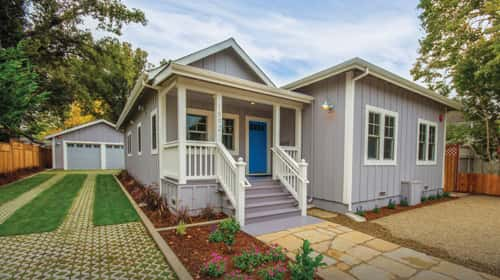Architects, designers, contractors, and all those involved in the construction trades are breathing a sigh of relief in seeing an upturn in remodeling projects. Homeowners too, who either do not want to or cannot move in our tight housing market, are elated to finally have money in equity again and feel confident enough in our economy to spruce up their homes, complete necessary repairs, and generally make their home work for them.
Cautious optimism
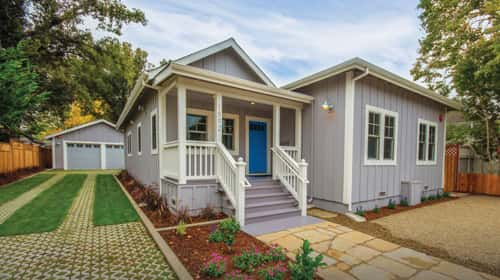 While growth in the remodeling industry has enjoyed a slow and steady growth since the economic recovery around 2011, most professionals in the industry are still experiencing ebbs and flows in business over the past few years, and overall, the first years of the new century have been volatile for the industry.
While growth in the remodeling industry has enjoyed a slow and steady growth since the economic recovery around 2011, most professionals in the industry are still experiencing ebbs and flows in business over the past few years, and overall, the first years of the new century have been volatile for the industry.
“We’ve gone in two spurts,” says Keith Woods, Chief Executive Officer of the Santa Rosa-based North Coast Builders Exchange, a 1,100 member-operated, not-for-profit association serving the construction industry in primarily Sonoma, Lake, Mendocino, and Napa Counties. “From 2000 to about 2006, there was a lot of remodeling going on because people’s equity in their home had spiked so much that they had money they could borrow against for home improvement. People could not only invest in their real estate, but also enjoy their investment while living in their homes. But from 2007 to 2014 a medium priced home of $600,000 dropped to $320,000, so there was no equity to borrow against and the remodeling and home improvement business almost disappeared. About a year and a half to two years ago we’ve seen a huge spike where those that have ridden out the recession have now seen their equity climb back up and now have money again to borrow against.”
Even when the economy started to improve, homeowners were still cautious, and banks and lending institutions have also tightened their lending practices. It is not as easy to get an equity line today as a decade ago. However, even with home prices not yet rising to the amount they peaked before the recession, the industry is enjoying the growth – nationwide and here in the North Bay. According to Metrostudy’s latest Residential Remodeling Index (RRI), remodeling activity grew nationwide at a 4.5 percent annual rate between July and September 2016, the 18th consecutive quarter of year-over-year gains.
institutions have also tightened their lending practices. It is not as easy to get an equity line today as a decade ago. However, even with home prices not yet rising to the amount they peaked before the recession, the industry is enjoying the growth – nationwide and here in the North Bay. According to Metrostudy’s latest Residential Remodeling Index (RRI), remodeling activity grew nationwide at a 4.5 percent annual rate between July and September 2016, the 18th consecutive quarter of year-over-year gains.
While necessary repairs like broken pipes were still going on throughout the recession, other repairs that could be put off, not to mention any remodeling or expansion of homes, almost came to a halt because of lack of equity.
“You see people finally able to afford repairs that they hadn’t necessarily been able to afford previously, or were cautious about spending money,” says Laura Hall, Realtor and Associate Partner with Terra Firma Global Partners, a boutique real estate company servicing Marin, Sonoma and Napa Counties. “So now people are getting their roofs fixed, their fences fixed, they are fixing their plumbing. The other portion is that we’ve had a strong investor market for the last four to five years. The distressed home market has pretty much run its course, but investors are buying homes in original condition, or original “character”. That means homes from the ‘50s, ‘60s, ‘70s, and some in the ‘80s, that really haven’t been touched. Sometimes the highest and best use for a particular client is selling to an investor and having that investor reinvest in the home and turn it out.”
Electing to stay
 Overall, however, the home remodeling industry has seen the most growth in recent years come less from home flipping and more from homeowners electing to remodel instead of moving. Why are people staying put?
Overall, however, the home remodeling industry has seen the most growth in recent years come less from home flipping and more from homeowners electing to remodel instead of moving. Why are people staying put?
“Many of the remodeling clients and professionals I work with have seen a significant increase in business over the past four years” explains Vicki Suiter, chair of the program’s committee for the North Bay National Association of the Remodeling Industry (NARI), an organization of high-quality remodeling industry professionals. Its members are committed to integrity, high standards, professional education and market recognition. “When the economy declined so significantly in 2008 and 2009, it put a huge damper on new construction, as well as remodeling projects,” she says. “In the rebound of the Bay Area it seems that more people are renovating and remodeling, rather than looking to purchase a new home. Homeowners are also being more cautious about the way they approach engaging with contractors. With so much information available on the web, it seems that people are doing more homework before engaging a contractor. Contractors who are part of a professional community such as NARI discuss these types of issues regularly and share ideas and resources to help them better work with the changing climate of customers.”
The bottom line, there simply is not very much new construction going on in areas where land is already limited. In addition, in Marin especially, the population is aging and people are less inclined to start all over again, given the tenuous nature of the economy.
“We always thought that real estate was the one investment that would never go down,” says Suiter. “That was the sure investment. But we saw in 2008 and 2009 that that wasn’t the case. What I notice is that people are more cautious.”
Another trend that professionals in the remodeling industry have seen in recent years is that people are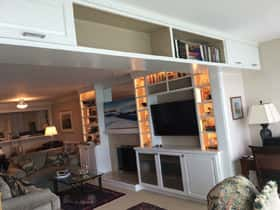 hanging onto their homes longer and trying to figure out a way to incorporate additional living space for either elders that they want to bring back home, or adult children. With rising home prices, it can make more sense to have multiple generations living under one roof, or on the same property, utilizing ADUs or JADUs.
hanging onto their homes longer and trying to figure out a way to incorporate additional living space for either elders that they want to bring back home, or adult children. With rising home prices, it can make more sense to have multiple generations living under one roof, or on the same property, utilizing ADUs or JADUs.
Officially designated by State bills as an “Accessory Dwelling Unit”, or ADU, these additions are also commonly referred to as granny units, in-law units, or backyard cottages. Essentially, an ADU is a separate self-contained smaller living unit with bathroom and kitchen facilities located on the same lot as the single family residence. It can be either detached or attached from the primary residence with a separate entrance. A Junior Accessory Dwelling Unit (or JADU) are units with approximately 500 square feet of living space contained entirely within an existing single-family home. A JADU may include a separate bathroom and kitchen, or it may share facilities with the existing home. They generally have a private entrance and are separate from the main living area, however, most have connecting doors that can be secured from both sides.
“We’re seeing regulations ease up a little bit on second units in town,” says Hall. “There is a big push to making things affordable, and part of that is working with your existing structure and land – not necessarily having to be on country property but trying to work within the city framework.
In areas like the North Bay where vacancy rates continue to be extremely low, ADUs can provide multiple benefits to a community including additional housing options that are more affordable, and allowing multigenerational families to stay closer together.
Adding value
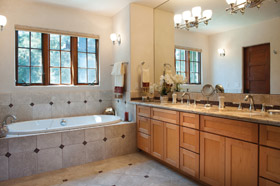 Because most remodeling clients today are undergoing these projects for their own benefits and looking at staying in their homes long term, choices are made based on comfort, personal preference, and family needs, rather than what will necessarily increase the value of their home. However, according to the most recent studies published by Remodeling Magazine, kitchens and bathrooms are not always necessarily where a homeowner looking to sell will get the most “bang for their buck.” It is often the cheaper projects that have the highest return on investment, most likely because in general, the lower-priced the project, the higher the percentage of costs come from materials. Kitchen and bath remodel projects, for example, take a lot of skill and labor. That being said, kitchens and bathrooms are still two areas that continue to be popular.
Because most remodeling clients today are undergoing these projects for their own benefits and looking at staying in their homes long term, choices are made based on comfort, personal preference, and family needs, rather than what will necessarily increase the value of their home. However, according to the most recent studies published by Remodeling Magazine, kitchens and bathrooms are not always necessarily where a homeowner looking to sell will get the most “bang for their buck.” It is often the cheaper projects that have the highest return on investment, most likely because in general, the lower-priced the project, the higher the percentage of costs come from materials. Kitchen and bath remodel projects, for example, take a lot of skill and labor. That being said, kitchens and bathrooms are still two areas that continue to be popular.
“We see families electing to stay in their homes longer instead of moving into a new home,” says Rick Wells, CEO of Marin Builders Association which aims to serve the construction industry by promoting high ethical and professional standards and providing quality services to its members such as project bid lists, insurance programs, and safety and education resources. “New kitchens and bathrooms remain the most popular. We also see the conversion of exterior spaces in an extension of indoor-outdoor living areas, kitchens, etc.”
Other popular upgrades include converting awkward floor plans into great rooms, both because those homes sell better and also because families prefer the open, spacious feel where families and friends can gather. For aging in place seniors, common remodeling projects include helping make their space more livable, with fewer stairs, walking ramps, and making ground level floors more functional.
A need for skills
A major factor that has been, and continues to be, a challenge for the remodeling industry (as well as the construction industry as a whole) is the lack of skilled labor. The recession exacerbated this problem even more as many professionals in the industry had to leave for lack of demand. Those remaining in the trades professions have been busier than ever, and the recent upturn in business has stretched resources even thinner. That fact, coupled with the recent trend of investors moving from buying and flipping single houses to focusing on small developments, has left the average homeowner often competing for skilled and licensed contractors.
“[Investors buying homes for investment purposes] was fast and furious for several years, says Hall. “But as prices have risen there have been fewer opportunities for investors to come and get that sweet deal and still make their numbers make sense. The investor market has switched and those that are still active in our marketplace are turning their businesses slowly towards small developments. Where before they were doing one home at a time, they are now working on projects with 4 to 10 or 12 homes at a time. So now those contractors are on those sites a lot longer.”
Whereas before contractors would work on one home at a time and then return back into the pool of availability, investment or not, now those contractors who are spending a lot more time on longer projects are being pulled out of the general marketplace. This has made it more difficult for the average homeowner to find tradespeople who are willing to do the little jobs. Higher demand for bigger remodels and bigger projects gives contractors an opportunity to be on the job longer, an easier way to make money than taking on multiple smaller jobs.
“The whole industry dropped 40 percent, statewide, from 2007 to about 2013, in the number of employees and payroll [of contractors and tradespeople],” says Woods. “It was a beat down. But now we’re coming back – there isn’t a week now that goes by that we don’t have several contractors walk in the door and want to join the Builders Exchange. We are a real bell weather of how the industry is doing and we’re doing better and so is the industry. The downside to this is that the competition for qualified workers is so intense that it is going to be a huge problem for potentially some time to come. It’s topic #1 in almost every meeting I go to – this epidemic of the labor shortage.”
Licensed is the safe bet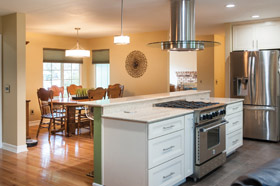
Even with the lack of skilled workers and the fierce competition this has caused for homeowners eager to get their projects completed, professionals in the industry still caution buyers to stick with licensed contractors. Ask a lot of questions, do the research, communicate in detail about the project and what you’re looking for, and then make an informed decision.
“The single biggest piece of advice I can give somebody is to only deal with licensed contractors – someone licensed by the Contractors State License Board,” says Woods. “I say that because there are so many people who have lost a lot of money from shady, unlicensed contractors. It’s tragic. People who think they’re going to get a bargain with an unlicensed contractor need to be very, very careful.”
Even better would be to hire a professional who can provide oversight of a project, possibly saving you time and money in the long run.
“I’m very committed to hiring a professional designer, a professional drafts person, or even so much as an Architect who can really help you save money in the long run,” says Hall. “You may be expensing for that particular professional, but this is what they do for a living. They know all the ins and the outs. They know that that particular manufacturer only makes cabinets this size and that if you’re trying to fit it in this bigger size you’re going to have an issue. Those little nuances that they do day in and day out in the long run will really help save people money, time, energy, and resources.”
In addition, professionals in those fields generally have contractors that they have vetted and have formed relationships with, helping a homeowner build a cohesive team and possibly progressing their projects in a more timely manner. Design professionals and Architects can also help clients interpret bids from contractors. A homeowner who is inexperienced with what to look for on a bid will tend to simply go with the lowest price. But not all bids are created equal and they could be comparing apples to oranges, possibly costing them more money and time in the long run when the inevitable change orders occur.
“Finding the right contractor to complete the work can be a challenge when the market is as robust as it is now,” says Wells. “Additionally, the permitting process can be daunting, costly and frustrating for both homeowners and contractors. Unfortunately this can lead to frustration and ultimately to unpermitted projects. We’re working with our members and officials across Marin on a permit simplicity initiative to help make this process more manageable. Our goal is to help keep costs down, speed up the process and ultimately increase the number of projects that are completed with permits.”
Permits, finding the right contractors, rising costs – there are many challenges homeowners face in completing a home improvement project. However, keeping an open line of communication with contractors can mitigate many problems. Change orders, for example, are almost inevitable and tend to amount to about 20 percent of the original contract value. While change orders can happen for a variety of reasons, and usually do, the majority of them tend to be from owners who didn’t make a clear decision on the front end or who made a different decision along the way.
“Information is power,” says Suiter. “The clearer you can be about the decision you’re about to make on a remodel of your home, the better experience you’re going to have. When you’re going to look for a contractor, as you’re talking to people, pay attention to how good they are at communicating. If they are a good communicator, that’s probably an indication of how the experience is going to go.”
With home prices continuing to increase and interest rates still being low, combined with a tight housing market and the growing trend of homeowners staying in their homes longer, all signs point to the remodeling industry continuing to grow over the next several years. That’s good news to both homeowners and contractors alike.


